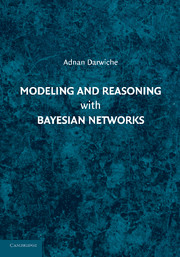Book contents
- Frontmatter
- Contents
- Preface
- 1 Introduction
- 2 Propositional Logic
- 3 Probability Calculus
- 4 Bayesian Networks
- 5 Building Bayesian Networks
- 6 Inference by Variable Elimination
- 7 Inference by Factor Elimination
- 8 Inference by Conditioning
- 9 Models for Graph Decomposition
- 10 Most Likely Instantiations
- 11 The Complexity of Probabilistic Inference
- 12 Compiling Bayesian Networks
- 13 Inference with Local Structure
- 14 Approximate Inference by Belief Propagation
- 15 Approximate Inference by Stochastic Sampling
- 16 Sensitivity Analysis
- 17 Learning: The Maximum Likelihood Approach
- 18 Learning: The Bayesian Approach
- A Notation
- B Concepts from Information Theory
- C Fixed Point Iterative Methods
- D Constrained Optimization
- Bibliography
- Index
9 - Models for Graph Decomposition
Published online by Cambridge University Press: 23 February 2011
- Frontmatter
- Contents
- Preface
- 1 Introduction
- 2 Propositional Logic
- 3 Probability Calculus
- 4 Bayesian Networks
- 5 Building Bayesian Networks
- 6 Inference by Variable Elimination
- 7 Inference by Factor Elimination
- 8 Inference by Conditioning
- 9 Models for Graph Decomposition
- 10 Most Likely Instantiations
- 11 The Complexity of Probabilistic Inference
- 12 Compiling Bayesian Networks
- 13 Inference with Local Structure
- 14 Approximate Inference by Belief Propagation
- 15 Approximate Inference by Stochastic Sampling
- 16 Sensitivity Analysis
- 17 Learning: The Maximum Likelihood Approach
- 18 Learning: The Bayesian Approach
- A Notation
- B Concepts from Information Theory
- C Fixed Point Iterative Methods
- D Constrained Optimization
- Bibliography
- Index
Summary
We consider in this chapter three models of graph decomposition: elimination orders, jointrees and dtrees, which underly the key inference algorithms we discussed thus far. We present formal definitions of these models, provide polytime, width-preserving transformations between them, and show how the optimal construction of each of these models corresponds in a precise sense to the process of optimally triangulating a graph.
Introduction
We presented three inference algorithms in previous chapters whose complexity can be exponential only in the network treewidth: variable elimination, factor elimination (jointree), and recursive conditioning. Each one of these algorithms can be viewed as decomposing the Bayesian network in a systematic manner, allowing us to reduce a query with respect to some network into a query with respect to a smaller network. In particular, variable elimination removes variables one at a time from the network, while factor elimination removes factors one at a time and recursive conditioning partitions the network into smaller pieces. We also saw how the decompositional choices made by these algorithms can be formalized using elimination orders, elimination trees (jointrees), and dtrees, respectively. In fact, the time and space complexity of each of these algorithms was characterized using the width of its corresponding decomposition model, which is lower-bounded by the treewidth.
We provide a more comprehensive treatment of decomposition models in this chapter including polytime, width-preserving transformations between them. These transformations allow us to convert any method for constructing low-width models of one type into low-width models of other types.
- Type
- Chapter
- Information
- Modeling and Reasoning with Bayesian Networks , pp. 202 - 242Publisher: Cambridge University PressPrint publication year: 2009



